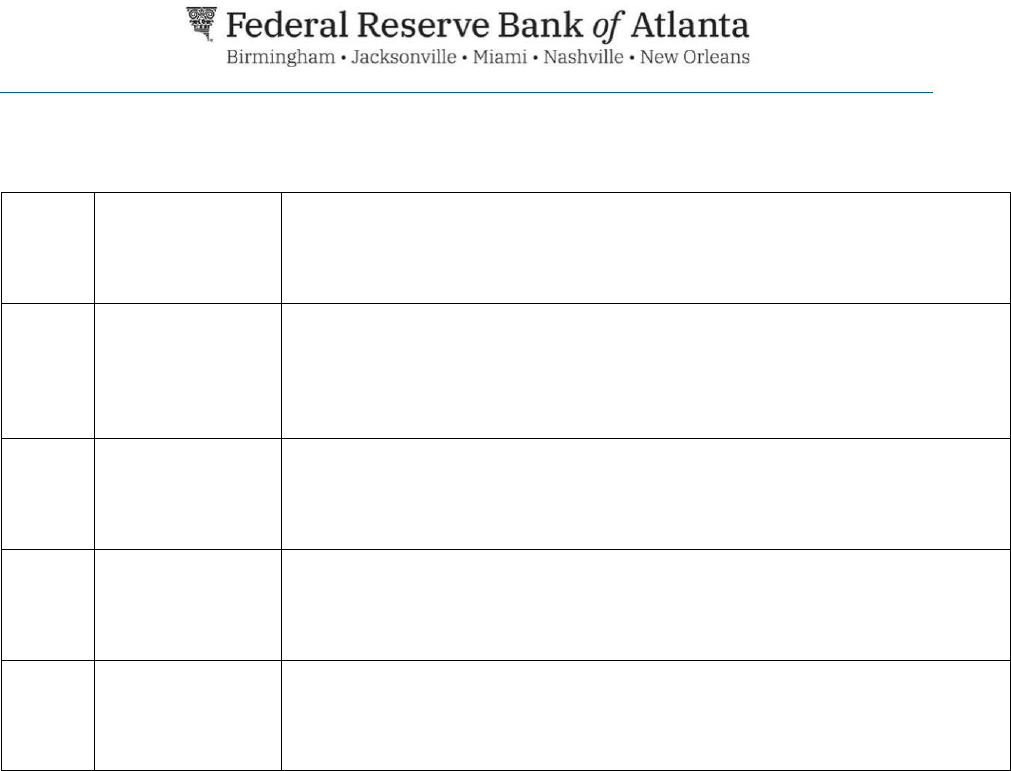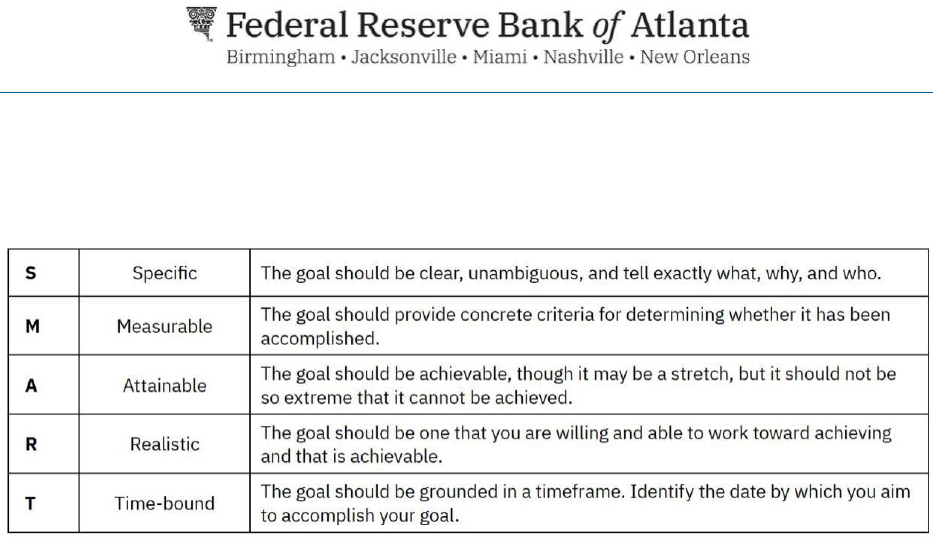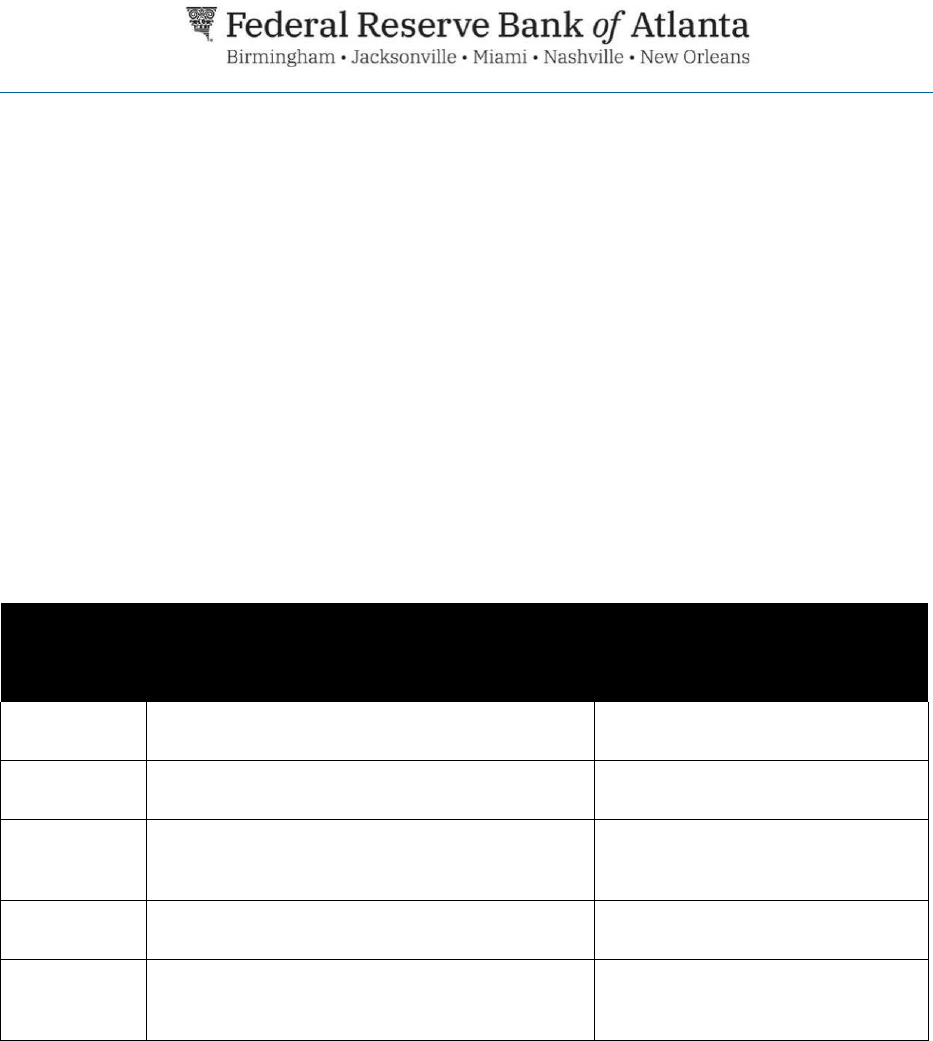
2
Financial Preparedness Infographic Activity: Creating SMART Goals
In this lesson students learn the difference between goals and SMART goals. Students develop goals for
given scenarios then use specific criteria to change the goals into SMART goals. Additionally, students
develop their own SMART goals and consider actions and obstacles to achieving their goals.
Grade Level
6–8, 9–12
Concepts
Emergency fund
Goals
Intermediate-term goals
Long-term goals
Short-term goals
SMART goals
Objectives
Students
will
be
able
to:
•
Identify types of goals.
•
Explain the difference between a goal and SMART goal.
•
Evaluate goals to determine if they meet the criteria of SMART goals.
Time Required
45 minutes
Essential Question
How do I prepare for my future?
Materials
Infographic: Financial Preparedness: Why Prepare for the Unexpected?
https://bit.ly/frba-infographic-preparedness
Visual 1: Life Scenarios
Visual 2: SMART Goals
Handout 1: Life Scenarios, one copy for each student
Handout 2: Turning Life Scenario Goals into SMART Goals, one copy for each student
Handout 3: Your SMART Goal, one copy for each student
Preparation
Display the infographic prior to beginning the lesson.

3
Procedure
1. Ask the students:
•
What is the difference between a dream and a goal? (Answers will vary; define goal as a
desired result of what we want to achieve)
•
Why are goals important? (Answers will vary; can help to achieve personal and financial
success)
2. Explain that goals are generally classified into three categories:
•
Short-term goals are those that you want to achieve in the near future, generally less than
one year. Ask the students:
o What might be an example of a short-term goal? (Answers will vary; examples
include developing a résumé and work portfolio, taking a class on a specific topic,
or creating an emergency financial plan)
•
Intermediate-term goals are those that you want to achieve in one to five years. Ask the
students:
o What might be an example of an intermediate-term goal? (Answers will vary;
examples include saving enough money to pay for the first year of college or
volunteering a certain number of hours to gain experience in a particular field)
•
Long-term goals are often our more meaningful and important goals. The timeframe on
long-term goals is generally five years or more. Ask the students:
o What might be an example of a long-term goal? (Answers will vary; examples
include graduating college or starting a business)
3. Distribute a copy of Handout 1: Life Scenarios and display Visual 1: Life Scenarios. Assign
students to small groups to develop short-, intermediate-, and long-term goals for each
scenario. Have each group share examples of the goals they identified. Ask the students:
•
What might make the goals you wrote more meaningful? (Answers will vary; having a more
specific set of criteria to see if the goals are achievable)
4. Display Visual 2: Smart Goals. Tell students that effective goals are written as SMART goals.
SMART stands for:
•
Specific—The goal should be clear, unambiguous, and tell exactly what, why, and who.
•
Measurable—The goal should provide concrete criteria for determining whether it has
been accomplished.
•
Attainable—The goal should be achievable, though it may be a stretch, but it should not be
so extreme that it cannot be achieved.
•
Realistic—The goal should be one that you are willing and able to work toward achieving
and that is achievable. For example, a short-term goal of losing 30 pounds in one month,
training for a marathon in one month, or saving to buy a new car in one month is not
realistic because it is typically not achievable.
•
Time-bound—The goal should be grounded in a timeframe. Identify the date by which you
aim to accomplish your goal.

4
An example of a SMART goal would be “I plan to get an A in this class by completing my homework each
night
throughout the semester.”
5. Tell students to review the goal on the bottom of Visual 2. Tell the students that the class
will be evaluating the goal “I want to have an emergency fund” based on the criteria of a
SMART goals and considering ways to revise. Define emergency fund as money set aside
that can be accessed quickly for unexpected expenses. Ask the students:
•
Is the goal specific? (No. The goal seems too vague.)
•
Is the goal measurable? (No. It could be made better by including definite numbers and
values.)
•
Is the goal attainable? (Perhaps, but we will only be able to determine that after the other
components are made stronger.)
•
Is the realistic? (Perhaps, but again more information could make the goal stronger.)
•
Is the goal time-bound? (No. A timeframe for attaining the goal should be added.)
6. Refer to the “An Emergency Fund Is” section of the infographic. Ask the students:
•
How much money is needed in an emergency fund? (3-6 months of living expenses)
•
In actual dollars, how much might that be? (It will depend based on each individual’s
actual living expenses)
•
If a person’s monthly living expenses were $1,000, how much is recommended to have in
an emergency fund? ($3,000 - $6,000)
•
Based on living expenses of $1,000 per month, what wording do you suggest to turn the
statement “I want to have an emergency fund” into a SMART goal? (Answers will vary;
examples include I plan to save $3,000 for an emergency fund by saving $200 per month
for the next 15 months or I plan to save $25 per week for the next 100 weeks to establish a
$3,000 emergency fund.)
7. Why is the revised goal stronger? (Answers will vary; it meets all the components of a SMART
goal)
8. Distribute a copy of Handout 2: Turning Life Scenario Goals into SMART Goals. Students will
again work in their small groups. Students should refer to the goals identified in Handout 1.
Students will select one goal from each scenario and turn those goals into SMART goals.
Have each group share examples of the SMART goals they identified. As each group shares,
ask the students:
•
Was the goal that was just shared a SMART goal? (Answers will vary)
•
If not, what could be changed to make it a SMART goal? (Answers will vary)
9. Distribute a copy of Handout 3: Your SMART Goal. Students will work individually to develop
an individual SMART goal. Once students have completed their SMART goals, have students
work in pairs to provide feedback to one another about their SMART goals. Ask the
students:
•
What was the most difficult part of developing your SMART goal? (Answers will vary)

5
•
Why is it important to consider challenges or obstacles? (Answers will vary; there may be
unexpected, or possibly anticipated, challenges that may cause a need to revise or review
the goal.)
•
Why is it necessary to consider additional steps needed to achieve your goal? (Answers
will vary; Refer to the “Make a Plan” section of the infographic; Having a good plan
provides the action steps necessary to meet the goal.)
•
How can you respond if you are finding that you are having a challenge meeting your
goal? (Answers will vary; Tell students that goals are not meant to be rigid and inflexible.
Regularly review the goal and plan to be sure it is working and revise the plan as needed to
accommodate the current situation. For example, if your goal is to save $75 per month for
the next year to purchase a new laptop, but you find that saving the $75 is too much of a
burden, change the amount and the timeframe to something that works so that you can
stay on track.)
10. Ask the students the following questions to close the lesson:
•
What is the difference between a goal and a SMART goal? (A goal is a desired result of
what we want to achieve and a SMART goal takes that goal and adds specific criteria that
can be measured to determine success.)
•
How do SMART goals help you prepare for your future? (Answers will vary; SMART goals
that are specific, measurable, attainable, realistic, and time-bound provide the details
needed to be on the path to success.)

6
Visual 1: Life Scenarios
Scenario #1:
James is a senior in high school and will graduate in 6 months. He currently works
after school as a cashier at a local grocery store. Because he likes working with
numbers, he hopes to work as an accountant someday and knows
that he must get a post-secondary degree in order to do so. James plans to apply for
some scholarships to help cover some of the cost of his education.
Scenario #2
Roxanne is a recent college graduate with some student loan debt that she hopes to pay
off in the next few years. She does not yet have a job but has had several interviews
with a few companies for jobs as a computer programmer. She is currently renting an
apartment and would like to one day buy a house.

7
Visual 2: SMART Goals
S
Specific
The goal should be clear, unambiguous, and
tell exactly what, why, and who.
M
Measurable
The goal should provide concrete criteria for
determining whether it has been
accomplished.
A
Attainable
The goal should be achievable, though it may be a stretch, but it
should not be so extreme that it cannot be achieved.
R
Realistic
The goal should be one that you are willing and able to work to-
ward achieving and that is achievable.
T
Time-bound
The goal should be grounded in a timeframe. Identify the date by
which you aim to accomplish your goal.
Turn the following goal into a SMART goal: I want to have an emergency fund.

8
Handout 1: Life Scenarios
Scenario #1
James is a senior in high school and will graduate in 6 months. He currently works after
school as a cashier at a local grocery store. Because he likes working with numbers, he
hopes to work as an accountant someday and knows that he must get a post-
secondary degree in order to do so. James plans to apply for some scholarships to help
cover some of the costs of his education.
Based on the scenario, identify potential short-term (less than 1 year), medium-term
(1–5 years), and long-term (more than 5 years) goals.
Short-term goal:
Medium-term goal:
Long-term goal:
Scenario #2
Roxanne is a recent college graduate with some student loan debt that she hopes to
pay off in the next few years. She does not yet have a job but has had several
interviews with a few companies for jobs as a computer programmer. She is currently
renting an apartment and would like to one day buy a house.
Based on the scenario, identify potential short-term (less than 1 year), medium-term
(1–5 years), and long-term (more than 5 years) goals.
Short-term goal:
Medium-term goal:
Long-term goal:

9
Handout 2: Turning Life Scenario Goals into SMART Goals
Refer to the goals identified in Handout 1 and the SMART goals guide. Select one goal
from each scenario and turn those goals into SMART goals.
Scenario #1
James is a senior in high school and will graduate in 6 months. He currently works after
school as a cashier at a local grocery store. Because he likes working with numbers, he
hopes to work as an accountant someday and knows that he must get a post-
secondary degree in order to do so. James plans to apply for some scholarships to help
cover some of the cost of his education.
SMART goal:
Scenario #2
Roxanne is a recent college graduate with some student loan debt that she hopes to
pay off in the next few years. She does not yet have a job but has had several
interviews with a few companies for jobs as a computer programmer. She is currently
renting an apartment and would like to one day buy a house.
SMART goal:

10
Handout 3: Your SMART Goal
Identify a goal that you have and develop a SMART goal.
Goal #1
General description of goal:
Is the goal a short-term (less than 1 year), medium-term (1–5 years), or long-term
(more than 5 years) goal?
SMART goal:
Evaluate your goal:
SMART
Criteria
Criteria Description
What words are used in your
goal to accomplish this
criteria? Or, how does it meet
the criteria?
Specific
The goal should be clear, unambiguous, and tell
exactly what, why, and who.
Measurable
The goal should provide concrete criteria for
determining whether it has been accomplished.
Attainable
The goal should be achievable, though it may be a
stretch, but it should not be so extreme that it can-
not be achieved.
Realistic
The goal should be one that you are willing and able
to work toward achieving and that is achievable.
Time-bound
The goal should be grounded in a timeframe.
Identify the date by which you aim to accomplish
your goal.
What challenges or obstacles do you anticipate in meeting your goal?
1.
2.
What additional steps or actions do you need to take to achieve your goal?
1.
2.

